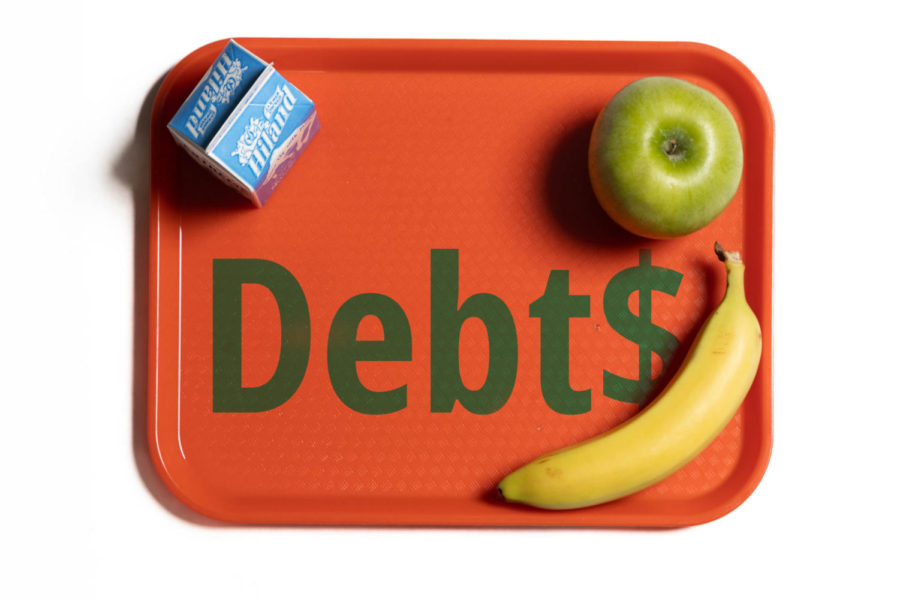Today’s menu: debt$
Districts across the nation rack up on debt due to school lunches
Photo Illustration: With the expiration of the CARES Act, public school students face daily expenses to purchase food at school. Texarkana ISD students accumulated almost $12,000 in meal debt in the first semester of the 2022-2023 school year.
January 30, 2023
Upon returning to school after the Christmas holiday, students found themselves still required to pay for their lunches to be able to eat at school. Even with free or reduced lunch waivers, schools across the country are racking up in unpaid meal debt.
In recent years, students did not have to pay for their meals due to the CARES Act, which allowed free meals for all students. This school year, the act is no longer in place, forcing students and parents to have to pay for their lunches. The district started communicating with stakeholders in the early summer of 2022 when the issue first arose. An immense amount of effort went into readying a plan for students’ meals this school year.
“The admin team at Texas [High School] has been wonderful,” director of child nutrition Christie Lammers said. “They started communicating back in the summer when they knew this was going to impact our kids and that it was, you know, a change from the way things have been in the last couple of years”
At Texas High, $5.30 is the average price for breakfast and lunch combined. Going to school five days a week, this is the only way some students are able to eat during the day, adding up per month to an average of $106. This accumulates to an even larger amount of $954 per every calendar school year.
“I try to bring my lunch from home as much as I can,” sophomore Leo Bevington said. “We actually have pretty decent lunch [at school], but my family can’t afford to pay that much a month for six different kids”
While some students can afford to pay this bill, they are often the ones bringing their lunches to school. The students who cannot pay for this meal bill have a chance to qualify for free or reduced lunch by applying, but the application does not always get approved for these waivers.
I see [being put on the delinquent list] completely unfair due to some kids not having the resources they need. The fear of being put on the list for a negative balance could keep them from eating when it is their only chance to eat.
— Zoe Riley
“We have noticed that a lot of kids have struggled with [paying for] their lunches this year because they had grown accustomed to the free lunch and families were dependent on that,” Lammers said. “I was sad to see [free lunch] go away. I thought it was a great thing for our students.”
In addition to many safety precautions in the 2022-2023 school year, parents are no longer permitted to drop off food to their children on campus. They now have to check in as a visitor and go sit with their child to be able to bring them lunch. The precaution implemented by the district’s safety and security committee removed another way for students to receive lunch.
“I feel like it is terrible that parents can’t bring lunch to school anymore,” junior Brooklyn Threadgill said. “Having lunch brought to school might decrease the negative lunch account balances.”
Food insecurity has also been a concern for the groups that did not get approved but still cannot afford to buy cafeteria food every day. The school does not want kids to struggle due to lack of nutrition or lack of funds on their lunch account. Due to this, superintendent Dr. Doug Brubaker created an unlimited charge policy that allows students to buy lunch whether they have money on their account or not.
“That does create a debt that the district is responsible for,” Lammers said. “We certainly don’t want to depend on the district to pay for those meals. That’s money we are not putting into classrooms, technology and things for our students.”
Not only can the lack of nutrition affect students physically, but their educational performance and emotional balance can also take a toll.
“Kids without proper nutrition don’t mentally function as they should,” American sign language teacher Britni Huggins said. “[Kids] don’t have any effect on how much their parents make. That can really mess with someone who is struggling emotionally.”
Texas High’s debt has accumulated to approximately $12,000 in meals students have not been able to pay for in the fall 2022 semester. The school serves around a thousand meals per day out of the cafeteria to students. This debt will continue to accumulate throughout the future if students continue to not be able to pay for their breakfast and lunch.
“[The debt is] why we still encourage people, even though it is January about to be February, to fill out applications [for free and reduced lunch prices],” Lammers said. “When [students] go to the cafeteria, no one will ever identify you as a free student, reduced student or paying student.”
The school has not experienced problems concerning money when it comes to supplying the students with food for breakfast and lunch. COVID-19 caused supply issues throughout the nation, but Texas High has simply adjusted its menu when problems with supply have risen to the surface. We have had people in the past that have called us and said they wanted to give a certain amount of money to pay off. We just select a student like a lottery system [to pay off their debt]. — Christie Lammers
“I wouldn’t say [the debt] has kept us from managing the food budget,” Lammers said. “Our biggest issue with getting food has been related to supply chain issues that are due to COVID.”
While the unlimited charge policy benefits the students in the moment of their needs, long lasting consequences can result from letting the lunch account debt grow. Students will be put on the delinquent list for having an outstanding account balance. The delinquent list prevents students from attending school functions like dances along with holding diplomas from students who are to graduate in the coming year.
“I see [being put on the delinquent list] completely unfair due to some kids not having the resources they need,” junior Zoe Riley said. “The fear of being put on the list for a negative balance could keep them from eating when it is their only chance to eat.”
Aside from the district having to deal with the consequences of students unable to pay the debt, outsiders will also occasionally call the school willing to pay off a student’s negative account balance.
“We have had people in the past that have called us and said they wanted to give a certain amount of money to pay off,” Lammers said. “We just select a student like a lottery system [to pay off their debt].”
The student body of Texas High will continue to eat from the cafeteria regardless of the balance of money on their account, causing a debt to the district similar to other schools around the nation.
“Even if a student does not have money on their account, they can still eat with us,” Lammers said. “I think everybody, the child nutrition and Texas High team, all had our kids’ best interests at heart. We want to get them qualified for free or reduced lunch so they are not faced with a negative account balance.”





















